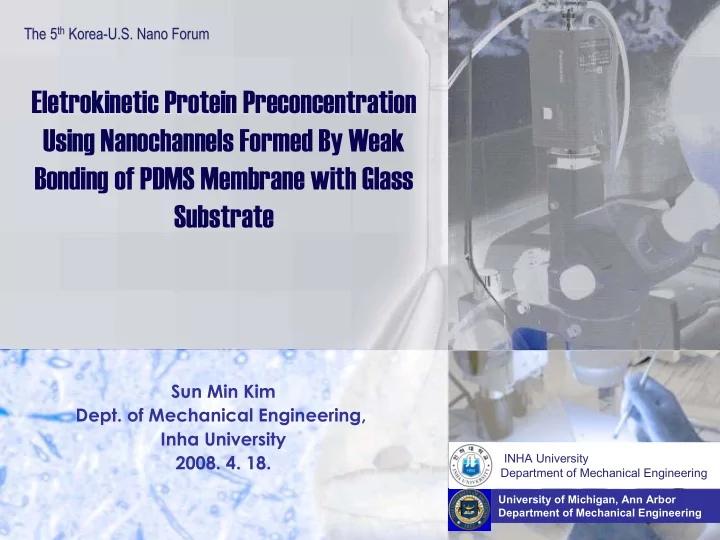

th Korea The 5 th The 5 Korea- -U.S. Nano Forum U.S. Nano Forum Eletrokinetic Protein Preconcentration Using Nanochannels Formed By Weak Bonding of PDMS Membrane with Glass Substrate Sun Min Kim Dept. of Mechanical Engineering, Inha University 2008. 4. 18. INHA University Department of Mechanical Engineering University of Michigan, Ann Arbor Department of Mechanical Engineering
Lab on a chip (Laboratory on a chip) Lab on a Chip Sample acquisition Sample preparation Analyte detection Analyte Concentration Analyte Amplification Why concentrate samples? – Sensitivity : Concentration in sample often less than detection limits of instruments – Waste : Most samples are > 1 mL in size, but only nanoliters can be analyzed at a time on a microchip INHA University -2- Bio-Micro Fluidics Lab. Department of Mechanical Engineering
Simple Glass/PDMS Preconcentrator GND GND GND GND GND GND M M’ 20µm – PDMS + PBS Buffer PBS Buffer PBS Buffer PBS Buffer PBS Buffer PBS Buffer Separation channel Separation channel Separation channel Separation channel Separation channel Separation channel 1 1 1 1 1 1 2 2 2 2 2 2 Glass M M M Gap:20 μ m Gap:20 μ m Gap:20 μ m Gap:20 μ m Gap:20 μ m Gap:20 μ m 5 5 5 5 5 5 3 3 3 3 3 3 M’ M’ M’ 4 4 4 4 4 4 PDMS PDMS PDMS PDMS PDMS PDMS PBS + Protein sample PBS + Protein sample PBS + Protein sample PBS + Protein sample PBS + Protein sample PBS + Protein sample Glass Glass Glass Glass Glass Glass + HV + HV + HV + HV + HV + HV + HV + HV + HV • Channel dimensions Chevron channels (W 40 µ m × D 18 µ m, L=16mm), Separation channel (W 30 µ m × D 18 µ m, L=40mm) • Microchannels are created by casting PDMS over a mold (SU-8 on a Si substrate). INHA University -3- Bio-Micro Fluidics Lab. Department of Mechanical Engineering
Experimental Results GND GND PBS Buffer PBS Buffer Separation channel Separation channel 1 1 2 2 Gap:20 μ m Gap:20 μ m 5 5 3 3 4 4 100 µ m 100 µ m 100 µ m PDMS PDMS PBS + Protein sample PBS + Protein sample Glass Glass + HV + HV + HV Experimental conditions •Protein sample : Fluorescein isothiocyanate (FITC) conjugate bovine serum albumin (BSA) and ovalbumin (OVA) •Buffer : Phosphate-buffered saline buffer (10mM, pH 7.4) and Phosphate buffer (20mM, pH 7.2) •O 2 plasma treatment of the PDMS (100W, 200mTorr, 3min) •Applied electric potential: 100, 200, 300V INHA University -4- Bio-Micro Fluidics Lab. Department of Mechanical Engineering
Experimental Results (cont ’ d) Concentration of FITC-BSA in the preconcentration zone 3000 1pM 100pM 10nM 2500 5 µ M standard 10 µ M standard Fluorescence Intensity (A.U.) 20 µ M standard 2000 1500 1000 500 Preconcentration Zone 0 0 5 10 15 20 25 30 35 Time (min) Concentration achieved up to 10 6 –fold INHA University -5- Bio-Micro Fluidics Lab. Department of Mechanical Engineering
Separation of preconcentrated proteins INHA University -6- Bio-Micro Fluidics Lab. Department of Mechanical Engineering
Physical Mechanism: Hypothesis and Verifications “ nanoscale channels ” formed between the PDMS and the glass due to the weak, reversible bonding 1. No preconcentration occurs in PDMS/PDMS and ir reversibly bonded PDMS/glass (stronger bond) chips. 2. Nanochannels work as a cationic selective membrane due to the Ion exclusion- enrichment effect (EEE) caused by electrical double layer (EDL) overlapping. 3. Electroosmotic flow (EOF) dominates over electrophoresis (EP) EOF EP M M’ – – – – – – – – – – ⊕⊕⊕⊕⊕⊕⊕⊕ ⊕⊕⊕⊕⊕⊕⊕⊕ M M M – – 1 1 2 2 Ⓘ ⊕ ⊕ Ⓘ PDMS Ⓘ – Ⓘ – Ⓘ Ⓘ Ⓘ Ⓘ ⊕ ⊕ Ⓘ Ⓘ Ⓘ + 5 5 – H m Ⓘ Ⓘ Ⓘ Ⓘ – – – – – – Ⓘ Ⓘ Ⓘ Ⓘ Ⓘ Ⓘ ⊕ Ⓘ ⊕ ⊕ ⊕ ⊕ λ D ⊕ ⊕ Ⓘ H n 4 4 ⊕ ⊕ ⊕ ⊕ ⊕⊕⊕⊕⊕⊕⊕⊕ ⊕ ⊕ ⊕⊕⊕⊕⊕⊕⊕⊕ 3 3 M’ M’ M’ – – – – – – – – – – – – – – – – – – – Glass INHA University -7- Bio-Micro Fluidics Lab. Department of Mechanical Engineering
Experimental Verifications Verification of the cationic selectivity of the nanochannel – Sample: 1µM Rhodamine 123 dye (cationic) in PBS buffer (bottom) INHA University -8- Bio-Micro Fluidics Lab. Department of Mechanical Engineering
Experimental Verifications (cont ’ d) Verification of the dominant electroosmotic flow (EOF) – Sample: 1µM FITC-BSA in PBS buffer (Top) INHA University -9- Bio-Micro Fluidics Lab. Department of Mechanical Engineering
Conclusions • PDMS / Glass chip for protein preconcentration was designed and fabricated. • Preconcentration of labeled BSA (FITC BSA) has been achieved up to 10 6 – fold. • Preconcentrated protein was injected and separated in a separation column. • “Nanoscale channels ” formed between the PDMS and the glass due to the weak, reversible bonding works as a cationic selectivity membrane by Ion exclusion-enrichment effect (EEE). INHA University -10- Bio-Micro Fluidics Lab. Department of Mechanical Engineering
Recommend
More recommend